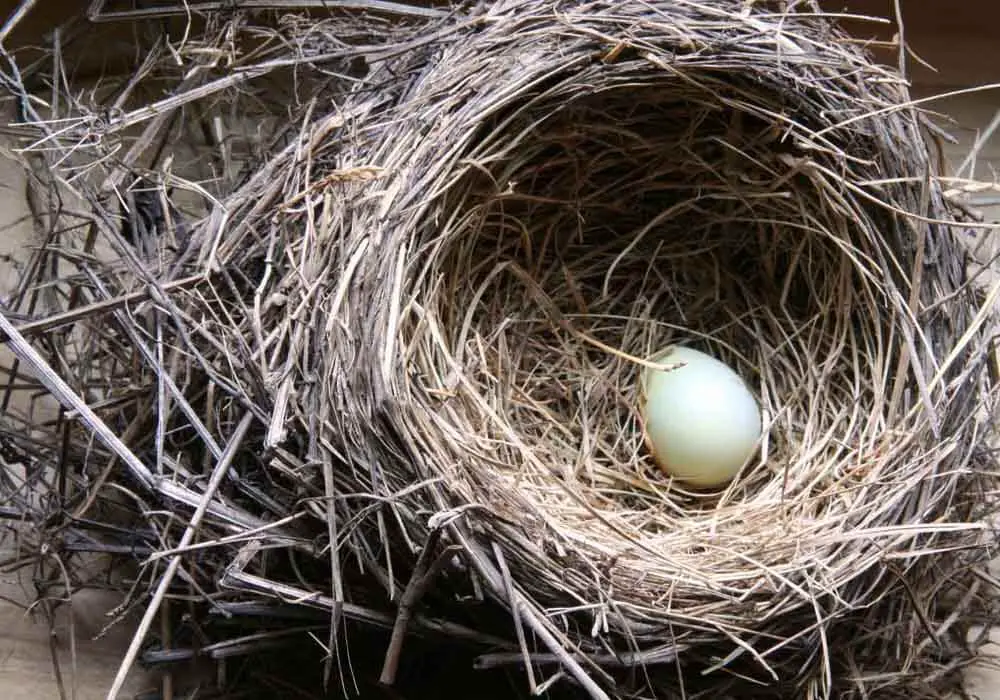What Is Inside A Bird Egg?
Birds’ eggs are endlessly varied and fascinating objects–it’s no wonder they’ve grabbed the attention of an incredible array of subject experts over the years. And it's not just zoologists; everyone from nutritionists to mathematicians seems obsessed with the humble egg. Curious? Let’s delve into what is inside a bird egg.
Bird eggs contain a germinal disk that may or may not develop into an embryo, yolk, a white portion, and other architectural features. The yolk and white include nutrients for the embryo’s growth. Shells, membranes, and fluids help the egg maintain shape and protect the contents of the egg.
Read on to learn more about this exciting topic. Along the way, we’ll also consider more high-minded questions, such as what an egg is, which came first, the chicken or the egg, and what notorious egghead Aristotle has to say about the shape of eggs.

The Contents Of A Bird Egg
Bird’s eggs are a marvel of nature. Their design ticks so many boxes that some have called eggs the most mathematically perfect objects in existence.
They are strong enough to survive exposure to a range of extreme environmental conditions and small enough to fit inside the bodies of the tinniest birds. They contain a rich soup of nutrients, making them among the most potent foods in the world.
It's no wonder they’ve been used as cult objects by cultures around the world for thousands of years. Today, eggs continue to inspire cutting-edge modern engineering.
But what’s all the fuss about anyway? Let’s start with the contents of what is inside a bird egg...
The Yolk
The yolk is the yellow part at the center of an egg. Strictly speaking, it can vary from the palest yellow to the most vibrant orange, depending on the species and diet of the bird. The richness of the color of a yolk indicates its fat content: the higher the fat content of an egg, the yellower its yolk, and vice versa.
Besides fat, a yolk also supplies most of the other nutrients an embryo will need through all stages of its development, from fertilization to hatching. In fact, other than proteins, most of the nutrients in an egg are present in its yolk.
Important minerals and vitamins present in egg yolks include:
- Vitamin A
- Vitamin D
- Phosphorus
- Calcium
- Riboflavin
- Thiamine
The yolk also contains most of the protein in an egg. These work as a source of nutrition for a developing embryo and coordinate the availability of the other vital nutrients.

So how do birds eggs get fertilized in the first place? Here's an interesting article of ours where we cover all the details...
The White
Because it’s mostly water (90%), the white or clear portion of a bird’s egg–also known as albumen–makes up more than 30% of its weight. It consists of a thin, runny layer–closest to the yolk–a thicker layer on top of this, and a final aqueous layer just beneath the shell membrane.
The albumin keeps the egg yolk suspended at the center of the egg and helps maintain the structural integrity of the egg. It provides lubrication, making it easy for a hatchling to make its way out when the time is right.
Egg white also provides supplementary nutrition in the form of proteins, minerals, glucose, and even some fat, although less than is present in the yolk. Finally, the globulins in egg white provide the embryo with a degree of disease resistance.
Its high water content means egg white also supplies most of the moisture an embryo needs throughout its development.
The Part That Grows Into a Bird
The germinal disc is a patch of cytoplasm that sits on the surface of egg yolk. It looks like a small white dot and provides the cells which grow into an embryo and eventually a hatchling.
Before fertilization, it is called a blastoderm and, once fertilized, a blastodisc. Of course, you’d be hard-pressed to notice any difference with the naked eye.
Supporting Architecture
Apart from the three main components described above, a bird’s egg also includes a few other essential features that help maintain the shape and structure of the egg and provide other essential functions. Without these features, eggs would be a scrambled mess.
Features that are vital to the architectural brilliance of an egg’s design include:
- The Eggshell, which is the egg’s primary line of defense against the cruel world outside. 95% calcium carbonate. Eggshells also include trace amounts of calcium phosphate, magnesium carbonate, and even minute quantities of organic material.
- The Cuticula is a layer of protein on the surface of the eggshell that stops moisture or bacteria from entering the egg, protecting it from infection.
- Allantoic fluid regulates the intake of oxygen and the expulsion of nitrogen, ensuring a cozy equilibrium of gases inside the egg.
- The Vitelline membrane is a protective layer between the yolk and the white that helps keep them separate while allowing the material to be exchanged when required.
- Chalazae are membranes that hold the yolk–the most precious part of the egg apart from the embryo itself–in place at the center of the egg.
- The Amnion is a protective layer around the embryo. Filled with amniotic fluid, it provides cushioning against the hard knocks of life. It is essential to the reproduction of birds, as well as all land animals, including reptiles and mammals. Even human reproduction is crucially dependent on the presence of amniotic fluids.
Pretty sophisticated for 300 million-year-old tech, you’ve got to admit!
If all that high school biology is throwing up some existential despair, fear not; we’ve got your high-minded queries covered too

There's a lot more to bird eggs than just the shell, white and yolk! Things that few know except for us and whoever reads this page of ours entitled All About Bird Eggs. Be sure to check it out!
What’s the Point of Eggs?
Biologically speaking, the point of an egg is to help one generation of birds produce the next.
It all starts with an ovum–a female reproductive cell which, when fertilized with a male reproductive cell or a sperm, develops into an embryo, which then develops into a fully formed individual of the species of bird (if all goes well, of course).
Instead of fertilizing ova inside their bodies, like humans and most mammals do, birds expel them outside their bodies (packed in very sophisticated containers, as we’ve seen earlier in this article).
If they have been fertilized, the individual ova will then develop into embryos and go on to become proper birds (again, potentially). Unusually–for much of the animal kingdom–bird eggs can be fertilized by multiple sperms–a process known as polyspermy.
Usually, apart from oxygen, all that’s required for development to maturity once an egg has been spit out by a relieved mother bird is incubation. Mostly, this involves just sitting on top of the egg or eggs to keep them warm. Gender equalists will be happy to note that daddy birds share egg-warming duties with mommy birds in many species.
However, some sneaky slacker birds have discovered a way out of incubation duties altogether: simply drop your future babies off in someone else’s nest and let them do all the hard work.
Additionally, since the most populous bird in the world today is the domestic chicken (Gallus gallus domesticus), many bird eggs today are hatched inside mechanical incubators. To paraphrase a wise elder, it’s all part of the great big circle of life!
Why Do Bird Eggs Exist?
All invertebrate species rely on amniotic eggs for reproduction, including mammals such as humans, but the revolutionaries vis-a-vis packing them away in eggshells outside their bodies were reptiles. what is inside a bird egg
Over 300 million years ago, when early reptiles were evolving from living in water to living on land, the egg was a crucial component of this transition.
The ingenious design of the egg allowed the materials inside it to retain their moisture in dry environments and keep out excess water in wet environments. At the same time, eggshells allowed oxygen to enter and carbon dioxide and water vapor to be expelled from eggs.
The design has been so successful that most species continue to reproduce this way. These oviparous species include most reptiles, amphibians, birds, insects, and arachnids. Most mammals, on the other hand, are viviparous: they give birth to live young.
However, as has already been pointed out, even mammals produce amniotic eggs, albeit inside their bodies. This inherited biological trait is in part derived from a reptilian ancestor, suggesting that all life on land is indebted to the humble egg.
How does oxygen get inside of a birds egg that appears solid?
This YouTube video helps explain it all...
Variations in Bird Egg Shape, Size, and Color
Having evolved over millions of years across diverse geographies and over every continent, birds' eggs come in a stunning variety of colors, shapes, and sizes. There are warbler eggs that are bright red and rich turquoise cuckoo eggs. The eggs of bowerbirds look like three-dimensional drip paintings.
It's not clear what exactly has influenced this astounding variety. Some suggest that the varied pigmentation keeps out unwanted light. Others claim that coloration works as a marker, thwarting those naughty bird parents who try to sneak their eggs into another bird’s nest. That they are a way for a bird to keep track of its eggs.
Similarly, bird eggs can be jelly bean-sized, as in hummingbirds, bowling ball-sized, as in ostriches, and everything in between.
In this case, the evidence is clearer. Larger birds lay larger eggs. So, while the hummingbird egg seems tiny compared to an ostrich egg, compared to the size of an adult hummingbird, its egg is appropriately sized.
Finally, the great variation in egg shapes has stumped great minds through the ages. Even foundational Greek philosopher and noted misogynist Aristotle took a crack at the problem. The famed author of erudite treatises on physics, metaphysics, ethics, and aesthetics erroneously claimed that pointy eggs contained female birds and rounder one's males. what is inside a bird egg
It turns out that the ovalness of a bird egg best maps onto a species' average hand-wing index. According to this theory, species that are better aviators have more elliptical eggs. However, this doesn’t account for penguins; go figure!
Are Bird Eggs Tasty?
Of course, they are! Because one of their primary functions is supplying nourishment to a developing embryo, eggs are particularly nutrient-dense. So, apart from being an essential device in the reproduction of many animal species, eggs are also an important source of food for many animals, including humans.
Common bird eggs consumed by humans include those of chicken, ducks, geese, turkeys, quail, and emus. Of these, the commonest, by far, is the chicken egg.
The average American consumes 277 of them each year, containing between 70-77 calories each. Each chicken egg contains 6 grams (0.2 ounces) of protein and 5 grams (0.18 ounces) of fat. It also includes many essential vitamins and minerals, including:
Because it's such an excellent source of nutrition, many animals eat bird eggs in the wild, including mammals, reptiles, and even other birds. High predation is the major reason some birds lay so many eggs. Many eggs just don’t make it to maturity.
- Selenium (22%)
- Riboflavin (15%)
- Vitamin B12 (9%)
- Vitamin B5 (7%)
- Vitamin A (6%)
- Vitamin E
- Calcium
- Phosphate
- Iron
- Carotenoids (which boost immunity)
- Choline (essential for brain development)
Is Eating Bird Eggs Bad for You?
It turns out eggs have been at the center of much controversy in recent decades. Laboratory studies have charged them with causing cardiac disease in the 1970s. More recently, nutritionists have flipped their position or been more ambivalent about the harm caused by eggs.
The constant see-sawing around whether eggs are good for your or not frustrated one author so much that they used it to highlight all that is wrong with nutrition science today.
Another common complaint regarding the humble egg attacks its origins.
The egg industry may not be as concentrated as the beef industry, but it's still often a factory-scale operation involving millions of birds cramped together in small cages, 6-10 to a cage, with cages placed one on top of the other.
Efficiently rearing hens at this scale have led to some pretty nasty management innovations, including:
- The killing of large numbers of unproductive male birds.
- ‘Modifications’ like trimming or removing beaks to prevent birds from being aggressive. what is inside a bird egg
- Stimulating molting to redirect nutrients into egg production.
- Diets intended to fatten birds, including antibiotics and other pharmacological ingredients.
Like many industries, the egg industry too has problems with overusing resources, polluting environments, and exploiting laborers.
Who knew so much that’s wrong in the world today could be manifest in a humble egg?
Which Came First, the Chicken or the Egg?
On a lighter note, I really have this one cracked: it's the egg, of course!
The first eggs were reptilian and over 300 million years old. In evolutionary terms, birds, and chickens, come much later. In fact, the wild chicken-ancestor has only been around for a few million years. So there were eggs hundreds of millions of years before the chicken.

Did you know we had a whole page full of links to other articles of ours that focus on bird eggs only?
Be sure to check out our Bird Egg Facts and Information page and you too can become an eggspert on eggs!
What Is Inside A Bird Egg...Conclusion
Birds’ eggs contain the ova of female birds and all the nutrients required for a fertilized ovum to develop into an embryo, and eventually–if all goes well–a hatchling. They are a crucial part of bird reproduction.
The design of the egg does a stellar job of protecting its contents from environmental threats. Without it life on land may never have happened. The egg is also a significant source of food for many animals, including humans.
Back To The TOP Of This What Is Inside A Bird Egg Page

About the Author...
Richard Worden, a dedicated bird lover for over 20 years, I love to share my in-depth knowledge and passion for birds. Read more About Me and my expertise in this field.
- We Know Birds HOME ›
- Bird Egg Facts and Information ›
- What Is Inside A Bird Egg?
